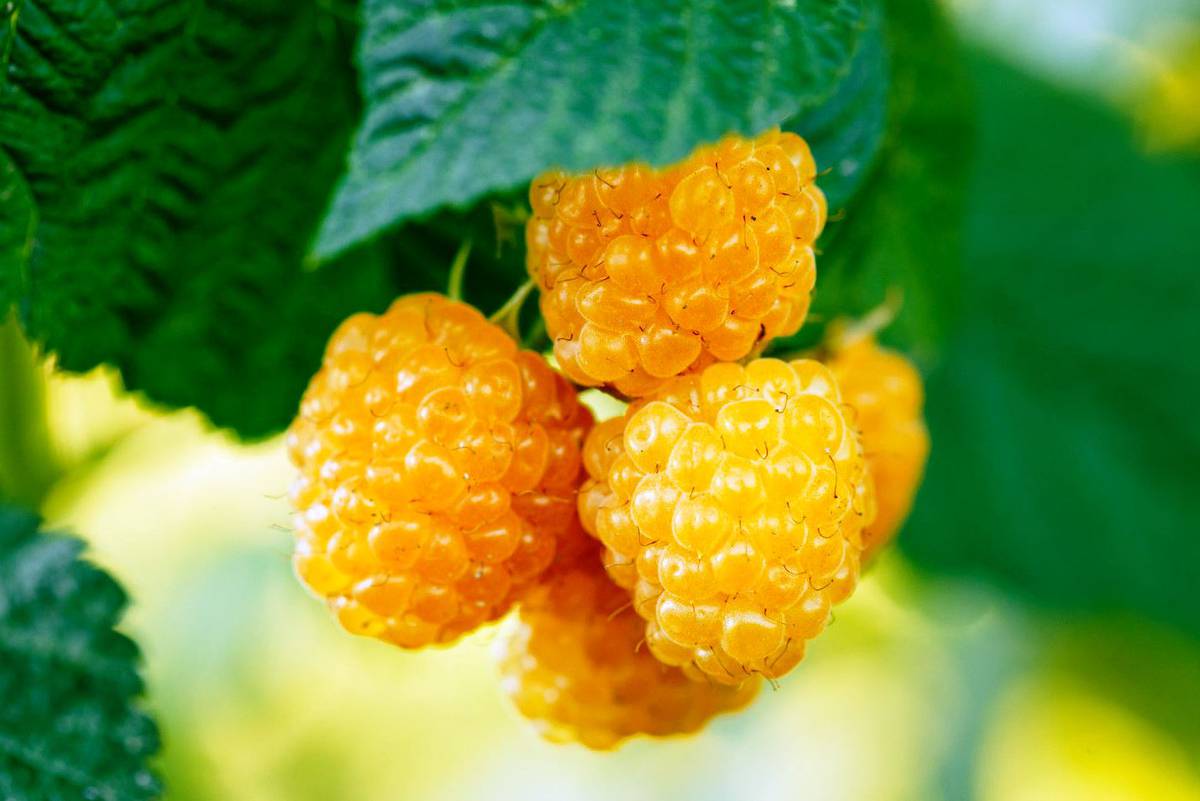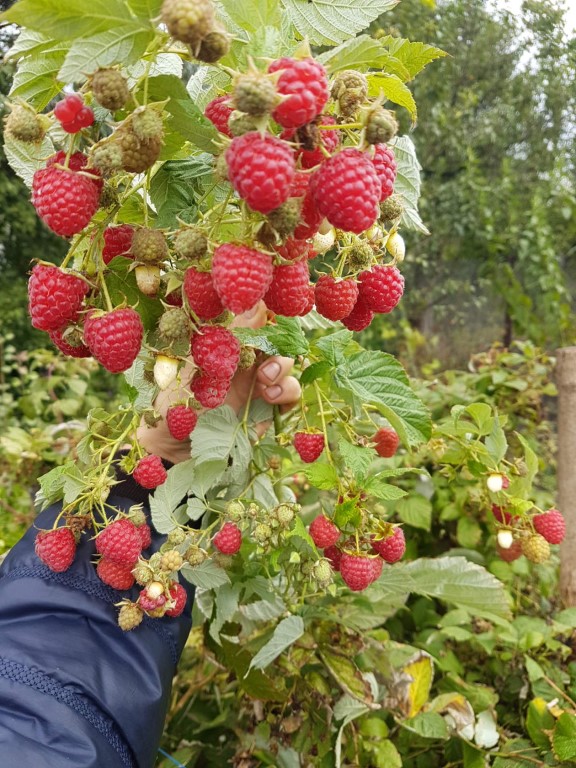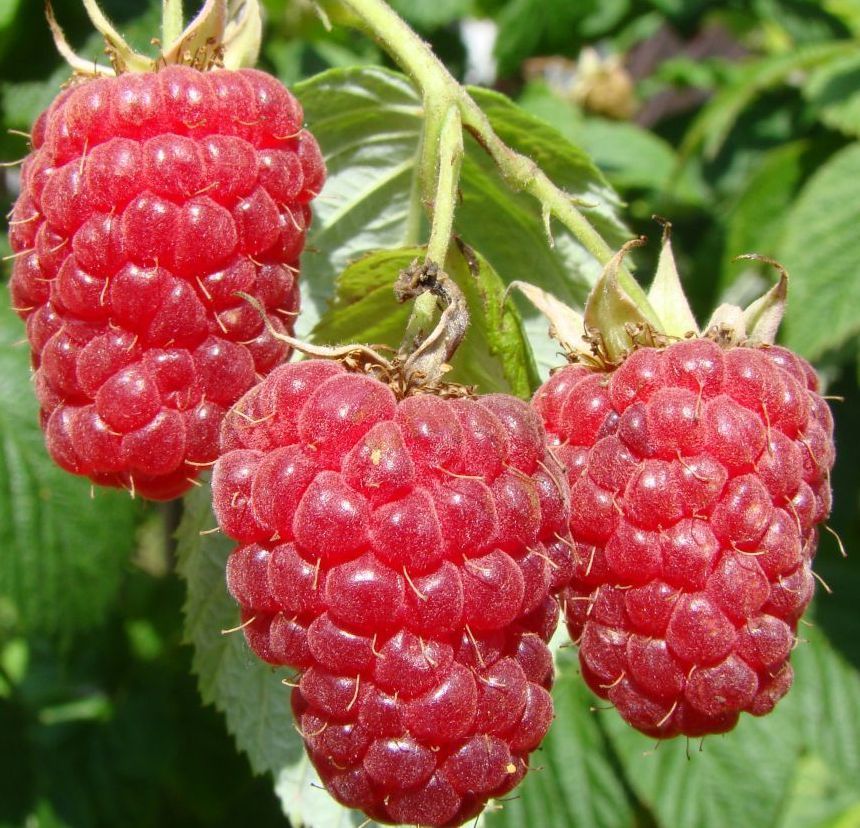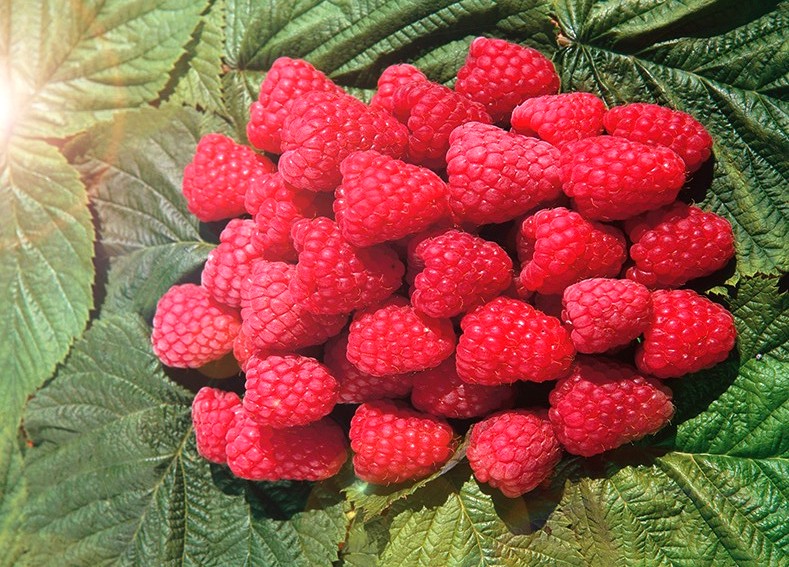Common raspberries are found everywhere in the garden plots and dachas of our country. But raspberry Glen Ample is still not so widespread. This new type of popular berry belongs to the standard type and, although it is an artisanal one, most of all resembles an ordinary tree.
Content:
Description of Glen Ample
Glen Ample Raspberry is a mid-late variety. Its main characteristic is the ability to grow in a short time to a height of more than three meters. Like any other raspberry tree, Glen Ample is an upright plant with a stem that looks like a trunk.
In the first year, the shoots of Emple are bright green, they begin to acquire a brown tint only in their second year. What is especially remarkable is that the described variety has almost no thorns. The upper part of the leaf of the raspberry bush has a distinct pattern, and the lower part is pubescent.
Glen Ample, as a new summer fruiting raspberry variety, has more than 20 lateral shoots capable of fruiting. At the same time, about 20 berries ripen on each of them. The average weight of berries can be from 4 to 5 g, while the largest fruits can weigh up to 10 g. With the described data, a gardener can harvest about 1.5 kg of harvest from each individual shoot during the season. Speaking on a larger scale, we are talking about 200 quintals of berries per hectare of raspberries.
Without exaggeration, the taste characteristics of raspberries can be called very high. They have excellent consumer qualities and tolerate transportation without any problems.
The advantages of the Glen Ample variety are obvious:
- high level of frost resistance;
- tolerance for dry conditions;
- good preservation of fruits;
- easy care;
- unsurpassed berry taste.
Many growers emphasize the high potential that this type of berry crop has.
On a note. On the basis of Glen Ample raspberries, three equally interesting varieties were bred: Glen Fine, Glen Erich and Glen Coe.
Description of Glen Fine
Another worthy representative of the Glen dynasty can be called the fine raspberry variety. Glen Ample is the parent variety of this raspberry. Raspberry Glen Fine in 2009 was recognized as the best variety in the UK. And it is not surprising - this varietal shrub demonstrates excellent productivity.
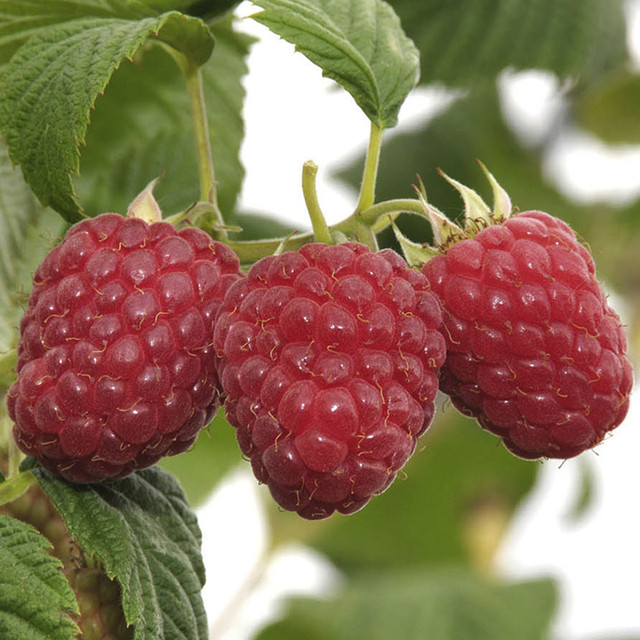
Outwardly, raspberry Glen Fine has almost no differences from its parent variety Glen Ample
Glen Fine is a medium early and thornless variety. It is equally well used for planting both outdoors and in greenhouse conditions. The stems of the shrub differ in power, and the average height of the shoots varies from one and a half to 1.7 m. The berries weigh 5 g, and the largest specimens grow up to 12 g.
The harvest time for raspberries of the described variety depends, first of all, on the planting region: from the beginning of June to July. The first fruits of Glen Fine appear a few days earlier than those of Glen Ampl, the fruiting period also ends a couple of days later. As a result, when grown on an industrial scale, the yield can be about 30 tons per hectare, and under the conditions of personal plots - about 4 kg per bush.
Description of Glen Coe
Raspberry Glen Coe was obtained in Scotland by crossing Glen Ample and black raspberries. The result is a very exotic variety, the berries of which have a rich purple color.
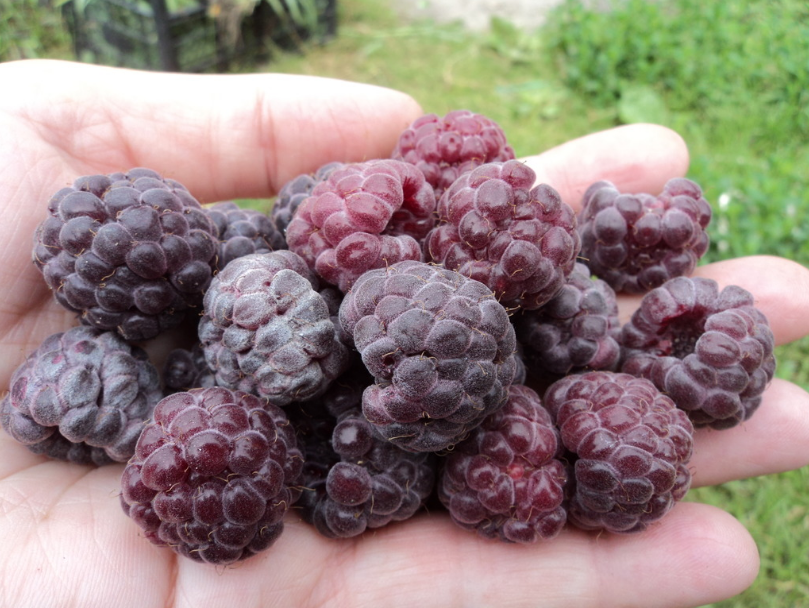
The main difference between raspberry Glen Coe is its color
Glen Coe is a fairly compact shrub, characterized by powerful, strong stems, on which there are practically no thorns.
Raspberries of this variety are medium in size. They are distinguished by a very sweet, pronounced taste that cannot but be appreciated.
From a commercial point of view, the purple color of Glen Coe fruits is an undoubted advantage of the novelty of breeding. It attracts attention from the consumer, as a result it is sold at an order of magnitude more expensive. The first fruits begin to be harvested in mid-July, and the last berries can be found on the bush even in September. The variety is very productive, the fruits keep well on the bush and do not crumble for a long time.
Raspberry violet Glen Coe is distinguished by the ability to resist most diseases characteristic of raspberries (verticellosis and root rot). It can be grown in almost any region, regardless of the climate.
Description Glen Erich
Another variety bred on the basis of Glen Ample is Glen Erich. It is distinguished by excellent yield and also belongs to the early varieties. Like its related varieties, it is resistant to root rot.
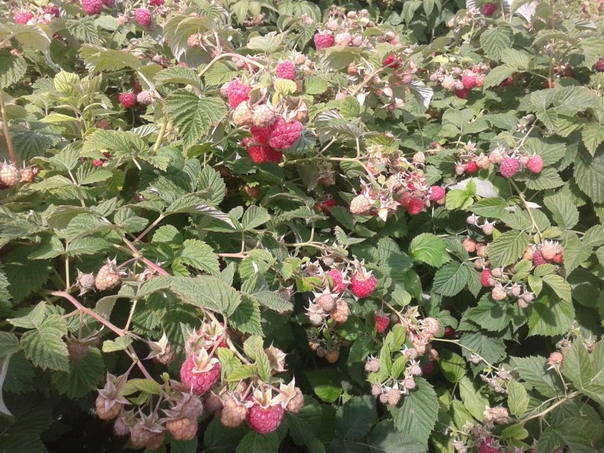
Raspberry Glen Erich - a worthy selection achievement
The Glen Ample bush is erect and studless, can reach 1.5-1.7 meters in height. The fruits ripen closer to mid-summer (the exact time may vary, depending on the region of planting). Yields 20% higher than their parent variety (Glen Ample). On average, more than 5 kg are collected from a bush per season. The berries are quite large (on average 5-6 g), dark red in color with an amazing aroma. They lend themselves well to transportation, including over relatively long distances.
Care of varieties
Despite the fact that the description of the varieties Glen Ample, Fine, Coe and Rich at a number of points varies significantly, the care for them is almost the same.
Landing
The type of raspberry Glen varieties in terms of care is not the most capricious. It can be planted in greenhouses or in open soil. In Europe, these raspberries are often planted in special film tunnels, and harvested mechanically. The varieties do not tolerate heavy and clayey soil very well. For planting plants, you should choose a place where the sun shines most of the day.
You can plant raspberries both in spring and before the beginning of winter. The bush is not particularly whimsical and easily tolerates strong winds, as well as dry weather.
On a note. The only thing to consider: the bushes grow well and require a lot of space.
Important! For spring planting, you can use seedlings prepared in the fall, left for storage in a cold place, or purchased seedlings. Autumn planting will require careful preliminary site preparation, which should begin at least one month in advance.
Experienced gardeners note the autumn planting of Glen varieties as more effective. The optimal disembarkation time is the end of September or the first half of October.
Top dressing
Top dressing of Glen varieties is usually done after and before winter.
In the spring, plants are watered with nitrogen compounds at the rate of 20-25 g per sq. meter raspberry. After the procedure, be sure to loosen the ground. Autumn feeding of plants is carried out after harvest in the process of preparing plants for wintering. The site is cleared of old mulch, dug to a depth of about 10 centimeters. When digging, wood ash and mulch are added to the ground, but this procedure should be carried out every two years.
Nitrogen fertilizers in the fall are completely unacceptable, since they promote the growth of young new shoots, which can easily be frostbitten with late leaf shedding.
Periodically, it is required to fertilize the soil on the site with the help of potassium-phosphorus fertilizers. This is done in grooves, 15 or 20 centimeters deep, about 30 cm away from the bush. This type of feeding contributes to the better laying of flower buds.
Watering
Like all fruitful varieties with relatively large and numerous berries, Glen is in vital need of regular watering. To simplify the process, experts recommend organizing special irrigation channels along the rows with plantings, so as not to pour water directly onto the bush itself (fertilizers can also be placed in them). When it comes to growing raspberries in regions prone to droughts, the organization of drip irrigation will not be superfluous.
In late spring and early summer, plants need especially abundant watering - up to 30-40 liters of water per bush on a daily basis.
Garter
In most cases, a garter of raspberry varieties Glen is required. It is produced by using the trellis method. The latter can be of the following varieties:
- horizontal;
- free;
- vertical;
- inclined two-sided plane.
At the same time, the principle of creating a structure for tying is the same: posts with a wire or rope attached to them (in one or two rows) are used.
Since we are talking about large-fruited raspberries, during ripening, the berries begin to pull down flexible stems. If the fruits end up on the ground, this inevitably leads to the development of rot on the berries and their infection with some diseases and pests. Growing raspberries on trellises is a great way to avoid all of these problems and, as a result of all the efforts made, get a decent harvest.
Pruning
Despite the fact that the Glen variety is called tree-like, you cannot do without pruning. In this case, pruning consists in removing shoots that have already managed to bear fruit. Most often, gardeners use the double pruning method (that is, they leave only one replacement shoot).
Pruning is done on shoots up to a meter in height in late May or early June. As a result, by the end of the season, a small bush with 5-6 lateral branches is formed. It is in this form that the shrub is sent for wintering.
The second pruning is carried out in mid-May, it involves shortening the side shoots by an average of 5-10 cm.
Reproduction
You can propagate raspberries of the Glen varieties by root shoots. So there are usually no problems with planting material. Reproduction in this case consists in separating the processes from the roots using an ordinary garden shovel together with the earth and transplanting to another place. Performing the described manipulation is permissible at any time of the season.
Preparing for winter
Preparing raspberries for wintering is another significant point in caring for a berry. In order for the plant to survive the cold season without problems, it is carefully bent to the ground, fixed and covered with straw. The latter is especially true for regions with little snow.
Important! In general, the Glen varieties are distinguished by a high index of frost resistance and can withstand cold temperatures down to -30 degrees.
In our country, the raspberry Glen varieties have not yet become widespread. But an increasing number of gardeners are beginning to give preference to them, taking into account all the undoubted advantages of this variety of garden berries.

